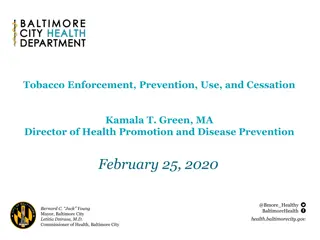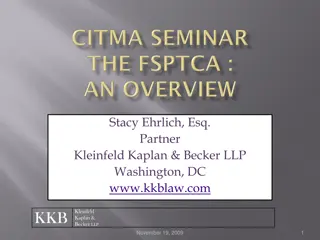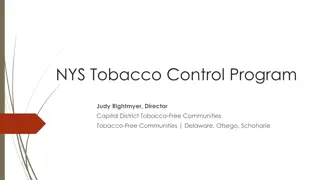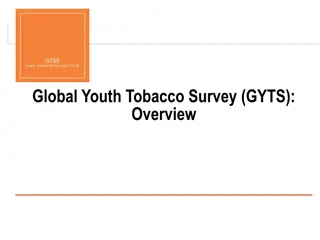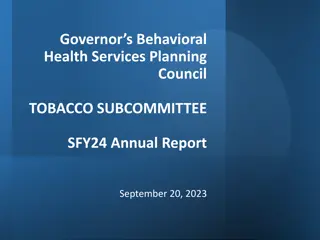Economics of Tobacco Taxation in Bangladesh
This study delves into the tax structure of tobacco products, demand elasticities, impact of cigarette tax increases on government revenue and public health, and proposes specific recommendations for tobacco tax policy reforms in Bangladesh. Primary and secondary data are analyzed, examining the supply chain of tobacco products and stakeholder perspectives. The research aims to provide insights for effective tobacco taxation policies.
Download Presentation

Please find below an Image/Link to download the presentation.
The content on the website is provided AS IS for your information and personal use only. It may not be sold, licensed, or shared on other websites without obtaining consent from the author.If you encounter any issues during the download, it is possible that the publisher has removed the file from their server.
You are allowed to download the files provided on this website for personal or commercial use, subject to the condition that they are used lawfully. All files are the property of their respective owners.
The content on the website is provided AS IS for your information and personal use only. It may not be sold, licensed, or shared on other websites without obtaining consent from the author.
E N D
Presentation Transcript
07 APRIL 2019 | TOBACCO TAXATION PROGRAMME ECONOMICS OF TOBACCO TAXATION IN BANGLADESH FUNDED BY THE UNIVERSITY OF ILLINOIS AT CHICAGO S (UIC) INSTITUTE FOR HEALTH RESEARCH AND POLICY TO CONDUCT ECONOMIC RESEARCH ON TOBACCO TAXATION IN BANGLADESH bigd.bracu.ac.bd BIGD_BRACU
Objectives of the study Methods of study Supply chain of tobacco products in Bangladesh CONTENTS Tobacco taxes Issues in tobacco taxation Price elasticities of demand Simulation Challenges of tobacco taxation Recommendations Specific recommendations for FY 2019-2020 bigd.bracu.ac.bd BIGD_BRACU
OBJECTIVES OF STUDY To examine the tax structure of tobacco products in Bangladesh; To elasticities of demand for tobacco products with a view to suggesting appropriate tobacco tax policy; estimate the own-and cross-price bigd.bracu.ac.bd BIGD_BRACU
CONTD To assess the impact of cigarette tax increases no government revenue and public health; and To propose specific recommendations on tobacco tax policy reforms. and administrative bigd.bracu.ac.bd BIGD_BRACU
METHODS OF THE STUDY Primary data Survey of 5036 stakeholders of whom 1000 farmers (7 districts), 192 manufacturers (26 districts), 997 retailers (14 districts) and 2847 consumers (16 districts). Conducted 23 FGDs (230 persons) with tobacco farmers and tobacco users (11 districts) and 25 KIIs with tobacco manufacturers and retailers (9 districts). bigd.bracu.ac.bd BIGD_BRACU
CONTD Secondary data HIES 2016 of BBS: 45,702 households, of whom 31,827 (69.64%) are rural and 13,875 (30.36%) are urban. HIES 2010 of BBS: 12,240 households, of whom 7840 (64.05%) are rural and 4400 (35.95%) are urban. Elasticity estimation Using Deaton Model (1997) estimated own-and cross -price elasticities of demand from HIES 2010 and HIES 2016. bigd.bracu.ac.bd BIGD_BRACU
Supply chain of tobacco products IN BANGLADESH Tobacco Farmers by Districts > NILPHAMARI > KUSHTIA > LALMONIRHAT > BANDARBAN > RANGPUR > COX S BAZAR > TANGAIL > MANIKGANJ bigd.bracu.ac.bd BIGD_BRACU
KAUS MIA, THE ZARDA MUGHAL Kaus Mia (87) has been on the list of the highest taxpayers nine times and has received a long time taxpayer award from the NBR. He has now different business enterprises, including the manufacturing of Hakimpuri Zarda Kaus Mia started the tobacco business in 1955. He set up the factory on a 3.5 katha (7 decimals) plot of land at Agha Nawab Dewri, Chawk Bazar, Dhaka with 4 floors. At present 20-21 workers are employed on a regular payroll. bigd.bracu.ac.bd BIGD_BRACU
CONTD Along with tobacco business, Kaus Mia is now the sole agent of 18 companies. According to the NBR data, he paid total taxes (income tax and VAT & SD) to the NBR amounting to Taka 49.47 crore (US$ 5.90 million) in FY 2017-18. bigd.bracu.ac.bd BIGD_BRACU
Market shares of different retail channels in Bangladesh Others, 1% Street hawker/street stall, 7% Supermarket/de partment store, 3% Grocery/Convenie nce Shop, 42% Tobacco kiosk/paan shop, 13% Tea Shop, 34% Sources: TTRD survey, 2018 bigd.bracu.ac.bd BIGD_BRACU
Buyers of tobacco products at retail outlet Cigarette Buyer Biri Buyer Type Percentag e Adult male 37.79% Adult male Adult female 11.48% Adult female SLT Buyer Type Type Percentag e 67.56% 8.78% Percentag e 44.47% 32.83% Adult male Adult female Adolescent male Adolescent female Children (boy) Children (girl) Adolescent male Adolescent female Children (boy) 31.01% Adolescent male Adolescent female Children (boy) 17.56% 13.45% 6.63% 1.15% 4.41% 11.02% 4.58% 3.11% Children (girl) 2.08% Children (girl) 0.38% 1.74% Sources: TTRD survey, 2018 bigd.bracu.ac.bd BIGD_BRACU
Prevalence of tobacco use (%) (GATS, 2009 and 2017) 58 60 46 43.3 40 35.3 Percentage 28.7 25.2 20 2009 2017 0 Male Female Overall bigd.bracu.ac.bd BIGD_BRACU
TOBACCO TAXES Revenue Collected and Health Cost of Tobacco Products, 2018 (in crore Taka) NBR revenue 206407 Revenue collected from tobacco products 22866.91 Economic cost of tobacco use 30570 Tobacco revenue as % of NBR revenue 11.08% Tobacco revenue as % of GDP 1.02% Economic cost of tobacco use as % of GDP 1.4% Sources: Faruque, G.M. et al., 2019. and National Board of Revenue (NBR) data bigd.bracu.ac.bd BIGD_BRACU
Tobacco Tax Structure in Bangladesh FY 2018-2019 Tobacco Products Tax base Price (Taka) VAT (%) SD (%) HDS (%) TTI (%) Category Low Medium High Premium Without filter (25 sticks) With filter (20 sticks) Zarda 35+ 48+ 75+ 105+ 12.5 15 15 15 15 15 15 15 55 65 65 65 30 35 1 1 1 1 1 1 1 71 81 81 81 46 51 116 Cigarette (10 sticks) Retail price Retail price Biri (Sticks) 15 12 100 SLT (per 10 gm) Tariff value Gul 6 15 100 1 116 Source: National Board of Revenue (NBR) data bigd.bracu.ac.bd BIGD_BRACU
ISSUES IN TOBACCO TAXATION TOBACCO PRICES AND TAXES Tobacco prices and taxes, Bangladesh and selected countries (in international purchasing power parity USD) Cigarette Country Price Taxes, % of retail price Pakistan 2.2 60 3.4 77 Bangladesh Indonesia Nepal Thailand India Sri Lanka 5.2 5.7 7.1 9.2 19.6 57 26 74 43 62 Source: WHO 2015 bigd.bracu.ac.bd BIGD_BRACU
SUBSTITUTION EFFECT Market Shares of Medium and Low Tiers of Cigarettes (%) 78.70 71.38 80.00% 59.80 Medium Low 52.51 50.89 60.00% Percentage 29.08 40.00% 25.46 21.85 15.67 11.11 20.00% 0.00% 2006-07 2009-10 2012-13 2015-16 2017-18 Source: NBR data bigd.bracu.ac.bd BIGD_BRACU
REVENUE SHARES Revenue Shares of Different tiers of Cigarettes (%) 8.02% Low 16.85% Premium 21.37% Premium FY 2017-2018 Tier-wise revenue contribution FY 2006-2007 Tier-wise revenue contribution 30.39% High 11.53% High 47.09% 44.74% Medium Low 20.01% Medium Source: NBR data bigd.bracu.ac.bd BIGD_BRACU
REVENUE GROWTH (%) Real Growth Rate of Cigarette and Biri Revenue FY 2011-12 to FY 2017-18 120 110.01 100 Biri Real Growth 80 Cigarette Real Growth Percentage 60 40 28.25 16.92 20 11.44 11.34 1.25 6.51 13.1 12.27 1.54 0 9.7 -10.17 -2.37 -20 -17.41 -40 2011-12 2012-13 2013-14 2014-15 2015-16 2016-17 2017-18 Source: Based on NBR and BBS data bigd.bracu.ac.bd BIGD_BRACU
AFFORDABILITY OF TOBACCO PRODUCTS Smokeless tobacco 0.1% Biri -2.3% Low cigarette brands 2.0% Medium cigarette brands -3.2% High cigarette brands -3.9% Premium brands -4.7% All cigarette brands -2.7% -6.0% -5.0% -4.0% -3.0% -2.0% -1.0% 0.0% 1.0% 2.0% 3.0% Source: Nargis et al, 2018 bigd.bracu.ac.bd BIGD_BRACU
Specific vs. ad valorem taxes With respect to the impact on tobacco product prices, ad valorem taxes result in greater price differentials between high and low priced products than is the case for a single specific tax. This creates more opportunities for users to switch down to cheaper brands in response to tax increase resulting in reduction in revenue. In terms of revenue, specific tax is likely to generate more stable and predictable revenue than ad valorem tax. bigd.bracu.ac.bd BIGD_BRACU
CONTD Specific excise taxes tend to be easier to administer than ad valorem tax. Empirical evidence from different countries shows that specific taxes are more effective than ad valorem taxes in reducing tobacco use and raising tax revenue (Barkat et al. 2012; Ho et al. 2018; Rodriguez-Iglesias and Blecher, 2018; Shang et al. 2017). bigd.bracu.ac.bd BIGD_BRACU
PRICE ELASTICITIES OF DEMAND The results of the study suggest that the overall consumption of smoking tobacco products does respond significantly to price changes. The poor households are found to be more responsive to the changes in the prices of cigarettes and biris than the rich households. This is expected as the poor households respond more to the changes in the prices of cigarettes and biris than the rich households. Therefore, using the tobacco tax structure to increase substantially the prices of tobacco products would lead to a substantial reduction in tobacco use, particularly among the poor while increasing government revenue. bigd.bracu.ac.bd BIGD_BRACU
Own-price Elasticities of Demand for Tobacco Products Expenditure quintiles Low (q1-q3) Rural/Urban Product HIES Overall High (q4-q5) Rural Urban -0.98*** (0.02) -1.33*** (0.034) -0.86*** (0.028) -1.20*** (0.05) -0.94*** (0.033) 2016 Cigarette -1.13*** (0.039) -1.02*** (0.067) -1.27*** (0.04) -1.16*** (0.06) -0.76*** (0.079) 2010 bigd.bracu.ac.bd BIGD_BRACU 23
Contd Expenditure quintiles Low (q1-q3) Rural/Urban Product HIES Overall High Rural Urban (q4-q5) -1.05*** (0.02) -1.03*** (0.024) -1.34*** (0.06) -1.10*** (0.056) -0.98*** (0.07) 2016 Biri -1.05*** (0.022) -1.04*** (0.022) -0.84*** (0.068) -1.02*** (0.028) -1.01*** (0.005) 2010 bigd.bracu.ac.bd BIGD_BRACU
Contd Expenditure quintiles Low (q1-q3) Rural/Urban Product HIES Overall High Rural Urban (q4-q5) -0.25*** (0.018) -0.27*** (0.019) -0.39** (0.03) -0.15*** (0.022) -0.15*** (0.04) 2016 SLT -0.37*** (0.04) -0.58*** (0.048) 0.16** (0.08) -0.11 (0.069) -0.16 (0.107) 2010 bigd.bracu.ac.bd BIGD_BRACU
SIMULATION Assumptions and Proposals A number of parameter have been used for simulation Policy interventions proposed are: Reducing the existing four price tiers of cigarettes to two: (1) lower tier (by merging low and medium tiers) and (2) upper tier (by merging high and premium tiers) bigd.bracu.ac.bd BIGD_BRACU
CONT The retail price of lower tier is proposed at BDT 50 with SD at 60% The retail price of upper tier is proposed at BDT 105 with SD at 65% In both tiers, a specific tax of BDT 5 per 10 sticks is proposed Two estimates of price elasticities (-0.98 of our study and -0.49 of Nargis et al. 2014) have been used to simulate the various revenue and health outcomes of policy interventions. bigd.bracu.ac.bd BIGD_BRACU
Alternative scenarios of simulation FY 2019-20 Price tiers Estimates of price elasticity Estimated Revenue growth Reduction in smokers (million persons) Deaths averted (million persons) total revenue (billion Taka) (%) Scenario A Low Medium High Premium -0.98 -0.98 -0.98 -0.98 316.47 13.86 3.03 1.00 bigd.bracu.ac.bd BIGD_BRACU
Contd Price tiers Estimates of price elasticity Estimated Revenue growth Reduction in smokers (million persons) Deaths averted (million persons) total revenue (billion Taka) (%) Low Medium High Premium -0.49 -0.49 -0.49 -0.49 Scenario B 365.32 31.43 1.27 0.42 bigd.bracu.ac.bd BIGD_BRACU
CHALLENGES OF TOBACCO TAXANTION Existence of a complex multi-tiered ad valorem excise tax structure. SLT is an area of growing concern for public health. However, there exists the challenges of regulating SLT products because of the informality of SLT products, which are often manufactured in small and unlicensed units. bigd.bracu.ac.bd BIGD_BRACU
CONTD There is an increasing trend in the affordability of tobacco products because of low prices and taxes in Bangladesh. Adopting a pragmatic tobacco taxation policy will bring a balance between protecting public health and mobilizing revenue from tobacco products. bigd.bracu.ac.bd BIGD_BRACU
CONTD There exists a conflict of interest among policymakers and government officials pertaining to tobacco tax. The government has more than 10% share in BTAB and some senior officers of the government sit on the Board of the BATB. Some Members of the Parliament have stake in tobacco business. bigd.bracu.ac.bd BIGD_BRACU
CONTD Several senior officials are involved in tobacco related CSR activities. National Board of Revenue (NBR) is not strong enough to enforce law effectively because of lack of adequate trained equipment and tracking system. manpower, modern bigd.bracu.ac.bd BIGD_BRACU
RECOMMENDATIONS Phasing out of the existing multi-tiered ad valorem tax system of cigarettes. Replacing the existing ad valorem taxes with specific taxes by amending the existing law. As the first step, the government can reduce the number of the current cigarette price tiers and add a specific tax to all the tiers in the existing ad valorem tax structure. bigd.bracu.ac.bd BIGD_BRACU
CONTD Increasing biri taxes substantially through a uniform specific biri excise tax that significantly raises biri prices and reduces its use. Formalizing SLT manufacturing units by bringing them under registration process and replacing the existing tariff value with the maximum retail price as the tax base. bigd.bracu.ac.bd BIGD_BRACU
CONTD Harmonizing tax rates across all tobacco products in order to avoid substitution of one tobacco product by another. Formulating a comprehensive tobacco tax policy and then Implementing annual adjustments to specific excise tax rates for retaining their real value over time bigd.bracu.ac.bd BIGD_BRACU
CONTD Strengthening the NBR by reforming its legal framework and enhancing its institutional capacity. Undertaking convince the government to address the conflict of interest in tobacco taxation. strong advocacy programs to bigd.bracu.ac.bd BIGD_BRACU
CONTD Earmarking tobacco tax revenue to support the programs for creating health awareness as well as for other comprehensive tobacco control programs. bigd.bracu.ac.bd BIGD_BRACU
Addressing Conflict of Interest The Ministry of Health and Family Welfare (Health Services Division) should take the initiative to raise awareness about Article 5.3 of the WHO FCTC among the Ministry of Finance, Ministry of Agriculture and Ministry of Industries. bigd.bracu.ac.bd BIGD_BRACU
Contd The government must withdraw all incentives provided to the tobacco industries including the exemption of export duty and VAT. The government should enforce the ban on the use of subsidized fertilizer for tobacco growing. bigd.bracu.ac.bd BIGD_BRACU
Contd The government must stop giving award for the highest taxpayer or the longest serving taxpayer award or any other recognition to the persons involved in tobacco business. bigd.bracu.ac.bd BIGD_BRACU
Contd Tobacco related CSR activities should be banned as required under Article 5.3 of the WHO FCTC. Moreover, the government should also take the initiative to offload its shares in the BATB. bigd.bracu.ac.bd BIGD_BRACU
SPECIFIC REMMENDATIONS FOR FY 2019 - 2020 Cigarette: Proposed Tax Structure FY 2019-2020 SD Retail price of 10-stick pack (Taka) Specific Compone nt (Taka per 10 sticks) Total tax share on retail price (%) SD* Ad Health Tier VAT* Development Surcharge* valorem Lower tier 50.00 5.00 60% 86.0% 15% 1% Upper tier 105.00 + 5.00 65% 85.8% bigd.bracu.ac.bd BIGD_BRACU
Biri: Proposed Tax Structure FY 2019-2020 Tier Retail price (Taka) SD SD* Ad VAT* Health Develop- ment Surcharge* Total tax share on retail price (%) Specific Component (Taka per valorem stick) Without filter, 25 stick pack Without filter, 12 stick pack Without filter, 8 stick pack With filter, 20 stick pack With filter, 10 stick pack 35 6 78.1% 16.8 2.88 78.1% 11.2 1.92 78.1% 45% 15% 1% 28 4.8 78.1% 14 2.4 78.1% bigd.bracu.ac.bd BIGD_BRACU
Smokeless Tobacco: Proposed Tax Structure FY 2019-2020 Tax base (Retail Price) TK./10 gm) 35.00 20.00 SD Specific Component (Taka/10g) SD* Ad VAT* Health Total tax share on retail price Development Surcharge* valorem (%) Zarda 5.00 3.00 75.3% 45% 15% 1% Gul 76% bigd.bracu.ac.bd BIGD_BRACU
Thank you bigd.bracu.ac.bd BIGD_BRACU
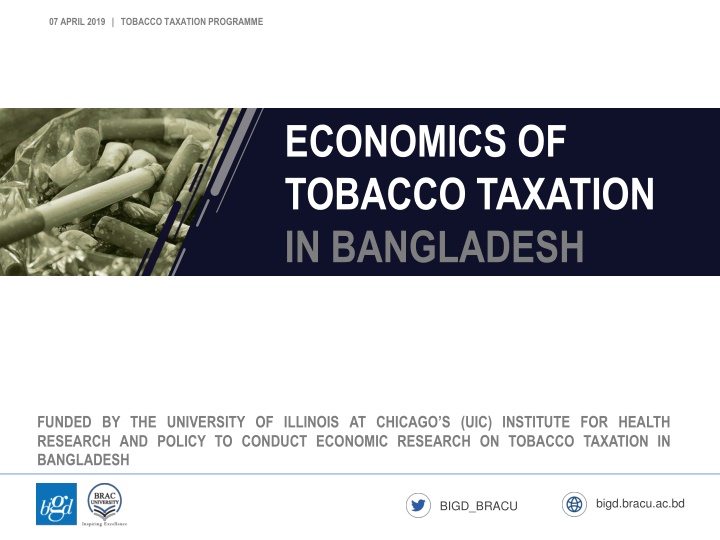


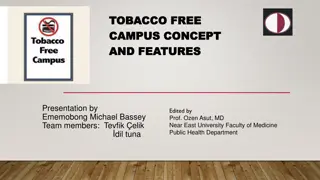
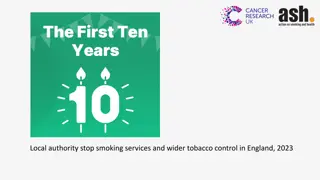
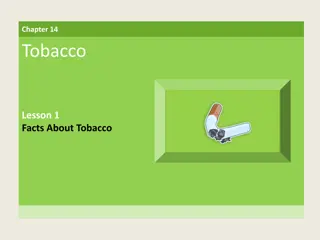
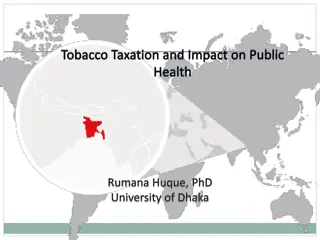
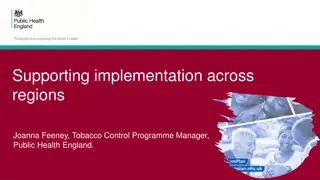
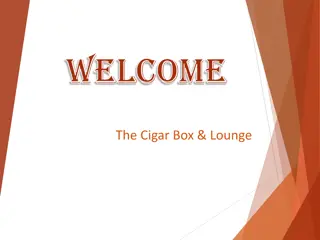
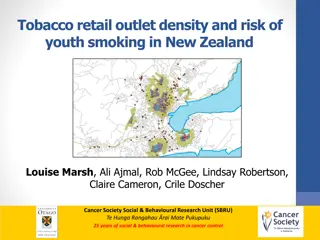

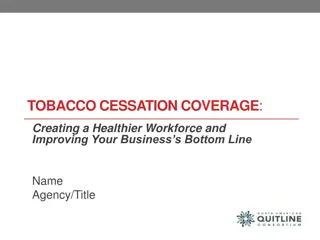
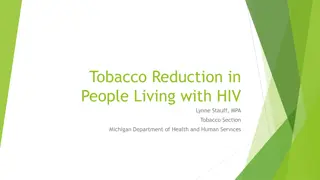
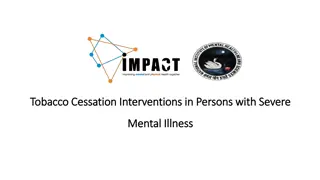
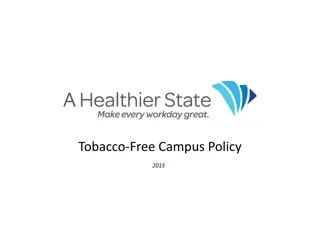
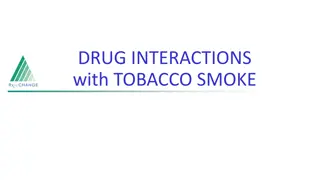

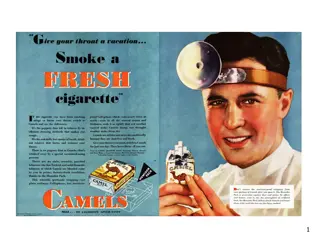
![Protecting Youth Through Tobacco Retail Licensing in [Your County]](/thumb/175307/protecting-youth-through-tobacco-retail-licensing-in-your-county.jpg)
